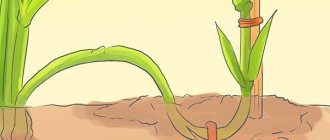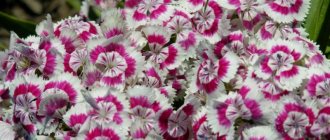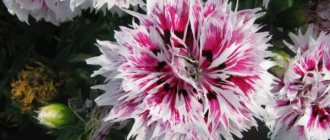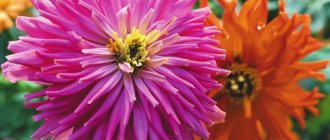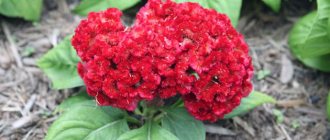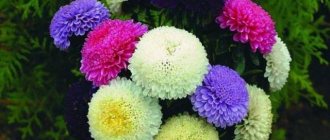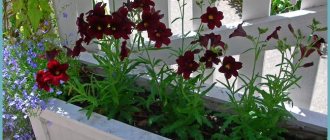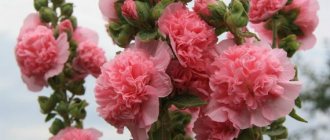A stereotype has formed that carnations can only be given to men or on days of mourning. But this is far from true. Anyone who was able to put aside all prejudices and consider the tenderness and sophistication in this flower begins to collect his own collection of these plants on the site. In the conditions of the middle zone, Siberia, and the Moscow region, it is safest to grow cloves through seedlings. Especially new, beautiful and valuable varieties. In this article we will tell you how to properly plant carnation seedlings and care for the seedlings at home.
How to choose a type 2. How to prepare seeds 3. Choosing the time of sowing 4. Choosing soil 5. Sowing seeds 6. What are the features of growing 7. Care rules
Photo: It’s quite easy to get beautiful, healthy cloves from seeds.
Seed selection and preparation
There are two ways to get clove seeds: buy them or prepare them yourself.
Clove seeds are sold in all stores. When purchasing, pay attention to the production date. Do not buy expired seeds at a discount.
If you already have cloves growing, it is easy to prepare the seeds yourself. A plant that grows outdoors is pollinated by wind and insects. And at home you must help the plant and pollinate it manually. It is recommended that when the flowers fade and begin to dry out, wrap them in a piece of nylon or organza. The ripened seeds will fall into this bag themselves. All that remains is to remove it from the plant.
Photo: If you already have cloves growing, it’s easy to prepare the seeds yourself.
I make it simpler. Carnations have a lot of flowers, so when I see a dry seed pod, I simply remove it and shake the seeds out of it into a box in which I either store them later or sow them right away.
Seed germination lasts 2–3 years.
Carnation pests
When growing cloves in the garden or on a windowsill, you may encounter aphids, mites or thrips on them. It is important to notice the appearance of insects on a flower in time, because they can not only damage the plants themselves, but also infect them with disease.
Aphid
Aphids are a pest of flower and vegetable crops.
Sucking insects are greenish, red, black or peach in color. Aphids spread diseases using their piercing-sucking mouthparts. Insects leave a sticky residue on the foliage that attracts ants.
Fighting aphids on carnations
Aphids have natural enemies - ladybugs and hoverflies. In open ground, you can attract them to the garden by planting fennel, dill, carrots and parsley. And fragrant lavender repels aphids. You can wash off insects from plants with strong water pressure.
To combat insects, insecticides are used - Bitoxibacillin and Aktara.
Spider mites
These are tiny arachnid pests of carnations and other crops. Ticks can be red, black, brown or yellow. Pests suck out plant juices and inject toxins. Because of them, the foliage turns yellow, becomes dry and covered in spots. Insects reproduce quickly and thrive in dry conditions.
Fighting mites on carnations
In order to prevent the development of the insect, it is worth regularly inspecting the plants and removing suspicious leaves.
Spider mites can be controlled with strong water pressure every other day and treatment with a soapy solution. This method is good for indoor plants.
If the above methods do not help, you should resort to the drugs Actofit and Actellik.
Thrips
Thrips - a harmful insect on carnations
These are tiny insects that are black or straw colored. They suck plant juices and attack the petals, leaves and stems of flowers. The plant will have dotted or discolored spots on the leaf surface. Thrips can transmit many diseases from plant to plant.
Fighting thrips on cloves
To prevent the appearance of thrips in the garden, in the fall, remove all plant debris and weeds, since pests can remain on them for the winter.
Many thrips will be repelled by sheets of aluminum foil placed between rows of plants.
Pests can be washed away with strong water pressure or by treating the plants with Fitoverm, Vertimek, Aktara, Actellik and Confidor.
When to plant clove seeds for seedlings
The most favorable period for sowing is considered to be from the end of February to mid-April. You can plant in stages. This way you will increase the flowering time of the plant. Those planted earlier will bloom earlier. Those planted later will bloom after those that bloomed first.
To grow carnations from seeds to seedlings as a home flower, you can sow them all year round, but it is best to do this closer to spring and summer. Sowing in open ground can be done in May. I sowed cloves in open ground in May and June, everything sprouted and took root by autumn. After my carnations have ripened seeds, I sow them immediately. This happens most often in August. By October I already have fresh shoots of young carnations.
Photo: Clove seeds are sold in all stores.
Landing
When planted in April-May, carnations bloom from August-September, when pinched twice, from October. The total harvest in the first year is 70-80 pieces per square meter of total area. With the second year crop, the total yield is slightly higher than with earlier crops, and the main harvest is obtained in June-July. Planting in June-July with traditional technology in the 1st year gives a small harvest, winter flowering is slightly higher than with earlier planting dates, mass flowering is also in June-July.
Clove cuttings
For soil culture, raised beds with or without sides are arranged. The sides are made of slate, boards or other building materials. For large areas, ridges are usually arranged, rising 10-18 cm above the paths. The width of the ridge is 120-130 cm, paths 30-40 cm.
Plants are planted in such a way that the distance between the outer rows is 110-150 cm. Carnations require skillful shallow planting, otherwise the lower part of the rooted cuttings comes into contact with the soil and begins to rot at high humidity and temperature; the waste can be very large, which is not usually associated with the quality of the cuttings. For this purpose, after making the beds, a mesh with a 5-8 cm point should be stretched at a height of 6-8 cm. Then planting is carried out. Small batches can be planted using wire support rings.
Planting a carnation cutting
Planting with cuttings laid out on the surface of the soil with the roots lightly covered with soil is also common. During hot hours, the cuttings are lightly sprayed. During the rooting period, maintain a slightly higher temperature. When cultivating cloves on mineral wool substrates, they are laid out on a carefully leveled soil surface. Uneven soil, the rack is sprinkled with sand and sawdust, a plastic film of standard width 140 cm is laid out on the leveled surface of the soil, rolling out the roll over the entire length of the ridge.
Planting density depends on the planting date and the planned flowering period. The required stem density to obtain a high yield in the first wave of flowering is 180-200 pieces per square meter of ridge area. This density is achieved by changing the planting density and the frequency of pinching (single, one and a half, double). During early planting periods (January-March), double pinching is used in order to obtain flowering no earlier than autumn.
In cuttings, generative organs are usually formed at the growth point; vegetative side shoots grow in the amount of 2-4 pieces. In this regard, at the end of May-July, up to 60 cuttings are planted per square meter of area. In this case, a one-time pinching is used and the required stem density of 180-220 shoots per square meter of ridge area is achieved more quickly.
Soil for growing
To grow carnation seedlings, ordinary “Universal” soil purchased in a store will be sufficient. If you make the soil yourself, then take equal parts of garden soil, peat and humus and add a little perlite or sand to them.
The soil must have a neutral pH. If you have acidic soil, like in the Moscow region or those who live near a coniferous forest, then add a little ash to the substrate.
| Advice. If you prepare the soil yourself, be sure to disinfect it. Spray with a solution of potassium permanganate or phytosporin. You can pour boiling water over it or freeze it in the freezer. |
Planting container
A container for planting seedlings can be of a wide variety of shapes and made of any material. This could be a plastic container with a lid left over from a cake, or a wooden box you put together with your own hands. Or a special mini-greenhouse, which is sold in the garden supplies department.
Photo: The depth of the container is no more than 8–10 cm.
Based on your capabilities. The main condition is that there are “good” drainage holes at the bottom. It's easy to make holes yourself by heating a nail. The depth of the container is no more than 8–10 cm, since in deep containers it is more difficult to control the moisture level. Containers must be clean. It will be ideal if you disinfect them with boiling water or pour a solution of potassium permanganate. Containers that have previously been used especially require disinfection. This preventive procedure will prevent the development of fungal diseases.
A drainage layer should be placed at the bottom of the container. This can be fine expanded clay or crushed foam.
Useful properties of cloves
There are many health benefits from eating cloves both internally and externally. The flower is known to help calm the nervous system, reduce muscle spasms, and improve heart health.
The flower has diaphoretic properties and is an aid in the treatment of dry skin, rashes and eczema. Cloves are used to make skin care cosmetics, including creams, lotions and perfumes.
Apart from physical problems, emotional problems can be eliminated or reduced by using cloves. This includes various nervous disorders, tension and nervousness, which is why the flower is often used in massage oils. In fact, their calming abilities are impressive, although many of them have not yet been proven by science.
To reduce or eliminate physical and emotional symptoms, cloves can be used in several ways:
- Clove essential oil . It can be purchased at a pharmacy or online store for indoor aromatherapy.
- Clove tea . Most often made from dried clove powder. For a glass of boiling water, use one teaspoon of crushed flowers and clove stems and leave for at least 5 minutes before use.
Scientists have proven that eating cloves alleviates many diseases. Including various inflammations, endometriosis, skin irritation, nausea, flu and cold symptoms, anxiety, PMS, diarrhea and sagging skin.
Of course, like many herbs and flowers, there are some contraindications that everyone should be aware of. The most important of these is the fact that cloves can stimulate the uterus, which means that lactating women and pregnant women should not consume it. It is recommended that you consult your doctor before consuming cloves, especially if you are taking any other medications.
How to sow cloves for seedlings with seeds
Depending on the type, the seeds of carnations differ. Some are very small, and some are a little larger.
If the seeds are small, like those of a feathery carnation, then there is no need to bury them in the ground. It is enough to simply sprinkle it in a thin layer over the surface of a pre-moistened substrate.
The seeds are slightly larger, like those of Turkish cloves. We plant the clove seedlings in grooves, at a distance of 2–2.5 cm from each other, and bury them 0.5–1.5 cm into the ground. Sprinkle them with a layer of earth on top. Then lightly press the seeds to the ground with your hands. We water the ground before we start sowing so that the seeds do not go deeper than necessary if we water after sowing. Then you can spray them 2-3 more times from a spray bottle and cover them with film or glass.
Photo: We place the crops in a bright and warm place.
We place the crops in a bright and warm place. It is advisable that the temperature in the room where the crops will be kept should not exceed + 18…+ 20 degrees. If you do everything correctly, then in 10–12 days you will have seedlings. After the emergence of seedlings, it is advisable to reduce the temperature to +12… +15 degrees.
We ventilate the crops daily. As soon as the seedlings hatch, we begin to increase the ventilation time. After a few days, we remove the lid completely. We put it in a brighter place. Plants need bright light, so it is advisable to use a phytolamp or a regular lamp.
| Advice. It happens that day and night the temperature in the room differs significantly. In this case, we continue to cover the young shoots at night. After 3 weeks, when the plants have 3-4 leaves, we pick up the seedlings. |
How to pick a carnation correctly
- We prepare the containers where we will dive in advance. These can be cassettes, cups or peat pots. It is very convenient to use transparent plastic cups. Through them you can see how the root system is growing, whether it is healthy, and also when a second transfer to a larger glass or planting to a permanent place of growth is required.
- We fill them with substrate. If necessary, make drainage holes.
Photo: Before picking, seedlings should be watered abundantly.
- Before picking, water the seedlings generously so that each seedling can be easily removed from the ground. And its roots, which were intertwined with the roots of other seedlings, were easily separated.
- Make a hole in the new pot with a pencil. We place a seedling in it. The root can be twisted in a spiral if it is long.
- We do not deepen the root collar. As the bush grew before, so we plant it.
- Lightly squeeze the top so that the plant “sits” in place.
- Pour water at room temperature. Place in a bright place, but without direct sunlight. You need to wait 2-3 days for the plant to take root in the new space. Then you can put it under the sun's rays.
Pinching the top
To make the plant lush, when it grows more than 5-6 leaves, pinch the top. The pinching is done over the third pair of leaves.
Soil composition and fertilizing
Cloves are grown on various soil substrates that have appropriate physical properties and good phytosanitary condition. The moisture capacity of the substrates should be 40-50%, air capacity 20-25% when completely saturated with water (after watering), pore volume 65-75%, density not higher than 0.7 g/cm3 per cube, organic matter 25-30%.
Such soils can be made from available materials: peat, sawdust compost, tree bark, decomposed humus. Steaming deep greenhouse soils with prolonged reuse for growing cloves is not effective enough, since the infection is located in deeper layers and causes re-infection of cloves with wilting diseases. The plant is very demanding regarding the level of soil nutrient supply. In one year of culture, from one square meter of greenhouse area, the removal of nitrogen is up to 80-100 g, phosphorus - 7-10, potassium - 120-150, magnesium - 30-35 g.
Cloves are a salt-tolerant crop that tolerates up to 0.8-1% water-soluble salts in the soil without visible inhibition. However, higher yield and quality are obtained with lower total salinity of the substrate.
The ratio of nitrogen and potassium in the substrate changes according to the growth phases. In young plantings in summer this ratio should be 1:1.2 in the water extract, and in winter in fruit-bearing ones it should be 1:2. If the soil is sufficiently supplied with nutrients, fertilizing the plants must be carried out regularly in small doses in accordance with the analyses.
It is advisable to combine watering with fertilizing. For this purpose, use solutions containing 1-3 g of solution per 1 liter of water. If it is necessary to more quickly increase the supply of nutrients in the soil, then you can apply up to 50 g of dry fertilizer per 1 square meter of ridge at a time, followed by abundant watering. When regularly combining watering with liquid fertilizing, a total salt concentration in the solution of 0.1-0.2% is sufficient. The role of individual nutrients has been studied quite well.
Nitrogen fertilizer
Nitrogen increases the mass and yield of flowers. But its high rates in the winter months increase the fragility of the stems and fragility, as well as the length of the internodes. If the plant has good water supply in winter, nitrogen should be at the lower limit. In summer, it is good to add ammonium nitrate and urea, but the total amount of ammonia nitrogen should not exceed 40% of the volume of nitrogen content. In winter, potassium and calcium nitrate as sources of nitrate nitrogen and calcium are indispensable in addition to other types of fertilizers. These fertilizers are also effective in summer.
Phosphorus fertilizers
Phosphorus has a positive effect on the color and size of flowers and enhances the growth of carnations, but in the soil solution the amount of mobile phosphorus is relatively small compared to its total reserve. The presence of phosphorus at a dose of 15-20 mg/l of soil in the water extract is already sufficient.
Potash fertilizers
When plants are in good condition and actively growing, potassium remains always high. Blooming carnations respond positively to an increase in the potassium content in soils to the upper recommended limit, especially in autumn and winter. Before budding begins, potassium levels are kept at the lower level, and then gradually increased to the upper level. With a lack of potassium, the lower leaves of plants dry out, growth rates on young shoots decrease, and plant resistance to certain diseases decreases.
Magnesium fertilizers
Calcium and magnesium are very important nutritional elements for cloves. The optimal amount of these elements in the soil ensures good growth, a strong stem, and eliminates numerous negative phenomena (drying of leaf tips, thinning of shoots). The addition of calcium nitrate, chalk and at the same time maintaining the pH reading at 6.6-6.7 provides the plants with calcium.
Boron fertilizers
Among microelements, the most important is boron . It activates the entry of potassium, calcium, and phosphorus into plants; it is active in a slightly acidic reaction; at a pH close to neutral (6.8-6.9), hard-to-reach boron compounds with calcium, sodium, and magnesium are formed. An annual application of 2-3 g of boric acid per square meter of soil is quite sufficient. For a hydroponic solution and periodic feeding with microelements, use the following composition per 1000 liters of water: iron sulfate - 10-15 g, zinc sulfate - 0.2, boric acid - 1.5-2, manganese sulfate - 1.5-2, copper sulfate - 0.15-0.2, ammonium molybdate - 0.1, cobalt sulfate - 0.1 g.
Features of growing carnation seedlings
Plant lighting
Almost all types of carnations love sunlight. Therefore, seedlings need to be provided with at least 5 hours of good lighting. Southwestern and southeastern window sills are ideal for this. Turkish carnation is not demanding of light, so it can be placed where there is less light.
Photo: Almost all types of carnations love sunlight.
Temperature
The suitable temperature for seedlings will be + 17…+21 degrees. But this is not important; cloves are not picky about temperature. The main thing is that it is not lower than + 14 degrees.
Watering carnations
Carnation loves moderate watering. Excessive moisture or prolonged drought will negatively affect the plant. Loves warm showers very much. Overall, this is not a fussy plant. Even if you forget to water it a couple of times, nothing will happen to it.
Feeding flowers
As soon as the plant grows 2-3 pairs of true leaves, and this will happen in about a month, we begin to feed it with any universal flower fertilizer. It is good to alternate feeding at the root and at the leaf. Foliar feeding is done through spraying.
Types and varieties of perennial carnations
In nature, there are up to 300 varieties of carnations, but about 10 of them are cultivated. Let's consider the most common types of carnations and loved by gardeners in Russia.
Turkish or bearded carnation (lat. Dianthus barbatus)
The most common species in Russia. The dense inflorescences of the plant contain up to 30 medium-sized (up to 2 cm in diameter) flowers that bloom simultaneously at the end of June.
Perennial Turkish carnation, Egyptian variety
A distinctive feature of this species is the combination of different shades in one inflorescence - from white to dark burgundy. Turkish cloves, the cultivation of which will not cause difficulties, grows quickly and tolerates winter cold well. Popular varieties: Little Willie, Purple Mountain, Egyptian, Ondine, Duplex, Black.
Feathery carnation (lat. Dianthus plumarius)
This type of carnation comes from the Alps and fits perfectly into rockeries and alpine hills. It differs from other species in having deeply incised leaves. Varieties of this species can bear both simple and double flowers, quite large flowers - up to 3 cm in diameter. The most popular varieties in floriculture are Sonata, Pleiada, Alba, Desdemona.
Pinnate carnation is ideal for growing in alpine hills
Chinese carnation (lat. Dianthus chinensis)
A perennial plant, but in Russia it is often grown as a biennial plant. Its leaves have a bluish tint. Flowers are single or bicolor, single or double shaped.
Chinese carnation variety Heddeviga - will decorate any flower bed
Chinese carnation flowers bloom in August. The bicolor garden form of the Chinese carnation Heddevig deserves special attention, as well as the famous varieties Schneebal, Lucifer, and Diana.
Perennial or Dutch garden carnation (lat. Dianthus caryophyllus)
It is characterized by continuous flowering from the second half of June until the first frost. Varieties of perennial carnation are bred based on the best representatives of this species, among which Scarlet, Carousel, Triumph, and Northern Lights deserve attention. The Dutch carnation became the progenitor of such famous forms as Chabot and Grenadine.
Dutch carnation blooms continuously all summer
How to care for cloves
If garden carnation seedlings are planned for planting in open ground, then before planting, we begin to harden them 2 weeks before planting, gradually moving them outside or onto the balcony.
Photo: Before planting in open ground, cloves must be hardened.
When the carnation grows in a lush clump, then at certain moments of the summer season it takes on the role of a soloist. Because other flowers either have not yet bloomed or have already finished blooming. Plant it in “islands”.
Can be grown in pots and portable containers. Containers are placed near the porch, along the paths and near the gazebo.
Caring for indoor carnations
Cloves are easy to grow at home. Turkish, Chinese or hybrid types of cloves are suitable for these purposes. They have low-growing varieties that will fit perfectly into the interior.
To grow seedlings, whether for the garden or for the home, you need to follow the same principle, which we described above. In the summer, it is advisable to take the houseplant out onto the balcony or porch. Make sure that the lump of earth does not dry out under strong sunlight. It is best to place the carnation so that it receives direct sunlight for several hours a day, and the rest of the time there is diffused bright light.
During the flowering period, you need to water more often, 1-2 times a day. You need to feed once every 10 days. In winter, it needs to be moved to a room where the temperature will be kept at + 5 ... + 7 degrees, reduce watering to almost nothing and no fertilizing until spring.
Photo: Cloves are easy to grow at home.
______________________________________________________________________________________________
Tips for caring for her
Carnations do not require careful care, but they need constant watering and light, both before and after germination. In order for you to grow a large and beautiful carnation, you need to follow several rules:
- After sowing, place the container in a room with a temperature of 18-20 degrees;
- Watering before emergence should be done from a sprayer; the cloves should be watered when the top layer of soil dries a little; the soil should not be allowed to be too wet;
- It is necessary to ventilate the mini-greenhouse; to do this, just remove the lid for 20 minutes once a day.
With proper care, the first shoots can appear within 4-5 days
Irrigation scheme
Watering before the emergence of shoots should be done from a sprayer and only as the top layer dries, and after the first shoots appear, watering should be done even more carefully.
In no case should you pour too much water in too large a stream; the plant is very susceptible to fungal diseases, and excess moisture can become a catalyst for the occurrence of these diseases.
Water should not be allowed to get on the stems and leaves; it is best to water the sprouts from a syringe
Top dressing
The carnation will delight you with its beauty if you take care of it in a timely manner; in addition to watering, you can sometimes feed the plant. At the initial stage of cultivation, nitrogen-containing fertilizers are suitable.
It is best to choose complex fertilizers that contain all the necessary substances.
Fertilizers must be applied strictly according to the instructions on the package; intentionally increasing the dose will only harm the plant.
Picks
Picking should be done only when you see that the plants have developed sufficiently and can withstand transplantation. The first pick should be no earlier than the first two green leaves appear, and the second – four leaves.
Before picking, you need to treat the soil and container, this is necessary in order to avoid any diseases
Carnation transplantation scheme:
- Before replanting, water the soil thoroughly;
- Prepare the container for transplantation: make drainage holes and lay a drainage layer, and fill the container with soil;
- Next, look how much the root has grown and make a hole slightly larger than the entire root system;
- Move the sprout to a new container and dig down to the cotyledon leaves.
After the procedure, you need to let the plants adapt a little, then they can be treated with a growth stimulator solution.
